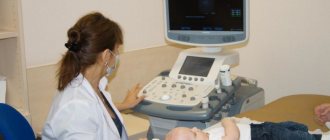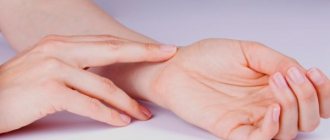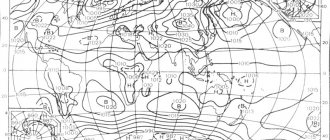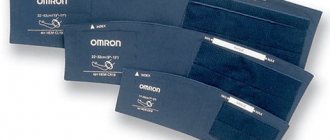Measuring with a ruler and pendulum
So, having obtained everything we need, let’s proceed to direct measurement. It will consist of several steps:
- Make a simple pendulum: thread a 20 cm long thread into a ring. By the way, the ring can be replaced with a needle or nut.
- Feel the pulse on your wrist, and place a ruler on the place where it can be clearly felt so that the zero mark on the ruler coincides with the pulsation point. The hand should be relaxed and located at heart level.
- Place the pendulum above the zero mark of the ruler so that the distance between them is 1-2 centimeters and wait until it is completely immobilized.
- Slowly move the pendulum towards your elbow. As soon as you notice that the pendulum begins to swing, look at what point on the ruler this happened and multiply this number by 10. For example, 7 × 10 = 70. This is the value of diastolic, or lower blood pressure.
- After this, without stopping, continue to move the pendulum along the ruler. After some time, the pendulum will begin to swing again, indicating the systolic, or upper pressure, level. This figure should also be multiplied by 10.
Please note that this method cannot guarantee accurate blood pressure readings.
Pulse measurement
You can determine your blood pressure without a tonometer by looking at your pulse. For this:
- Take a watch with a second hand or a stopwatch.
- Sit on a chair and take a comfortable position.
- Relax.
- Feel the pulse on your wrist.
- Within 30 seconds, measure the number of beats.
- Multiply the result by 2.
As a result, we got the number of heart beats per minute. Now we need to analyze the result: if we get a result less than or equal to 60 - blood pressure is low, 60-80 beats per minute - blood pressure is normal, more than 80 - blood pressure is high.
Hypertension
Photo from achieveclinical.com
The diagnosis of “hypertension” (also known as arterial hypertension, arterial hypertension and essential hypertension) is given to a patient if his blood pressure is higher than 140/80.
After making a diagnosis, it is very important to get checked by an endocrinologist, and first of all, determine the levels of glucose and insulin in the blood, since their increase is very often the main cause of high blood pressure.
People with type 2 diabetes are often obese, which is another risk factor for cardiovascular disease, so hypertension and insulin resistance are quite closely related.
A patient suffering from both diseases is prescribed a diet that helps lower blood sugar levels and also lose weight. To do this, you should completely eliminate or significantly reduce the consumption of foods containing sugars and starches, that is, baked goods, pasta, rice, cereals, and potatoes. It is also advisable to limit fruits somewhat, but not completely exclude them, since they are an important source of vitamin C, which is necessary for hypertensive patients.
Old and proven advice to all those suffering from cardiovascular diseases is to regularly eat citrus fruits.
It is important to ensure that the level of fructose consumed is no more than 25 grams per day. For reference : one average orange contains 6 g of fructose, banana - 7, peach - 6, apple - 9.5, pear - 12.
The fact is that one of the breakdown products of fructose is uric acid, the accumulation of which leads to several disorders, including hypertension.
Of course, if you have high blood pressure, you should give up alcohol and smoking - however, these two factors are unnecessary for any ill health.
With hypertension, it is very important to pay attention to whether the pressure decreases at night. If it remains elevated early in the morning, you should definitely check your heart as well as your vitamin D levels. The best way to optimize your body's vitamin D levels is to get regular sun exposure, but if you can't avoid taking extra vitamin D, choose a product that contains the active ingredient. its form is vitamin D3 (not D2).
An excellent source of vitamin D is fish oil. By taking it, you simultaneously replenish your body with omega-3 fatty acids, which, as scientific research shows, also have a cardioprotective effect.
Many experts recommend a salt-free diet for hypertensive patients, especially those whose hypertension is associated with kidney disease (and this is a very common combination of diseases). This issue, however, should be approached carefully and individually.
Photo from deccanchronicle.com
On the one hand, salt actually increases blood pressure, on the other hand, a lack of the main source of sodium can lead to an imbalance in the sodium balance in the body, which often causes a decrease in insulin production and leads to cardiovascular diseases. Therefore, the decision to limit salt should be made taking into account the patient's comorbidities. If such a decision is nevertheless made, hard cheeses, milk, beef, eggs, and rye bread will help replenish sodium in the body.
It's no secret that high blood pressure is often a consequence of stress, especially in middle-aged and elderly people. Advice to avoid troubles would sound strange, because they happen regardless of our will. It is useful, however, to master one or another technique of emotional control. There are many of them, and anyone who sets such a goal will be able to find something that is right for him to maintain peace of mind.
An important part of the prevention and treatment of arterial hypertension is physical exercise. An exercise program for hypertensive patients should include not only aerobic exercise (with a pulse range of 140-160 beats per minute), but also anaerobic exercise (with a pulse range of 160-180 beats per minute), which largely contribute to improving the functioning of the heart and lungs, and reduce risk of cardiovascular diseases.
This includes fast sprints, jumping rope, weight training, climbing steep hills, and any activity that involves heavy loads.
Under no circumstances should you immediately start intense exercise, as this can lead to the exact opposite result. It is best to start with fast walking, jogging, cycling, swimming.
What other ways
The symptoms accompanying this disease will help determine high/low blood pressure. Let's look at some of the most common ones.
Headache. With hypertension, the headache is concentrated in the occipital region and is pulsating in nature, and intensifies during movement or when tilting the head.
Pulse. A rapid pulse, which can be easily felt when pressed lightly, indicates increased blood pressure.
Skin. The complexion takes on a reddish tint with a visible capillary network.
Redness of the eyes also indicates the presence of high blood pressure.
Other symptoms of high blood pressure. Tinnitus, dizziness, floaters before the eyes, increased body temperature, increased sweating, nausea, shortness of breath.
With low blood pressure (hypotension), a weak thread-like pulse, pale skin, dizziness, and drowsiness are observed.
Pressure: high and low
Blood pressure problems are common. Moreover, there can be two of these problems: low or high blood pressure, that is, hypotension and hypertension. What is the difference between these states, besides the numbers on the tonometer screen? And which one is more dangerous?
Who does it happen to?
Hypotension
As a rule, hypotension is a manifestation of vegetative-vascular dystonia (more correctly called somatoform dysfunction) - a disease in which the functioning of the autonomic nervous system (ANS) is disrupted. This part of the nervous system regulates the functioning and interaction of other body systems, and, in particular, maintains vascular tone.
In addition to dystonia, hypotension can be caused by various disturbances in the functioning of the heart, a decrease in blood volume (with increased loss or insufficient fluid intake), and the use of certain medications and narcotic drugs.
A typical hypotensive person is thin and pale, but this does not have to be the case. The condition is more common in women and usually appears in adolescence or young adulthood.
Hypertension
In 90% of cases, hypertension is a primary disease (not provoked by other diseases), which occurs due to complex disorders of water-salt metabolism and regulation of the cardiovascular system. In the remaining 10%, it complicates diseases of the kidneys and endocrine system.
A typical hypertensive patient is dense and full-blooded, although, again, this is not necessary. As a rule, primary hypertension begins at the age of 30-35 years and later; in women, its onset may be associated with the onset of menopause.
Pressure level
Hypotension
There is no clear lower limit for blood pressure. If a person feels normal with blood pressure below the average, this is not considered hypotension. Typically, low blood pressure begins to be felt when the pressure is less than 95-90/65-60 mmHg. Art., but this figure is individual.
Hypertension
The upper limit of absolutely normal pressure is 130/85 mm Hg. Art. Blood pressure 130-140/85-90 mmHg. st is called elevated normal and indicates the risk of its further increase.
Anything over 140/90 mm Hg. Art. – this is hypertension.
Manifestations
Hypotension
Hypotension is manifested by lethargy, drowsiness, decreased performance, fatigue, a tendency to faint, aching headache - in general, all the “charms” characteristic of the state of a sleep-deprived person. All of the above manifests itself especially strongly when the weather changes - hypotensive people are weather dependent.
Orthostatic or postural hypotension is also common - severe weakness combined with flickering spots or darkening in the eyes when moving from a horizontal to a vertical position, for example, when getting out of bed. This occurs due to the low tone of the blood vessels, characteristic of hypotension - when standing up, the blood flows away from the head under the influence of gravity, leaving the brain on a starvation diet, and the vessels cannot quickly compensate for this.
At the same time, chronic hypotension is rarely so severe that it leads to serious problems. However, it happens that the pressure regulation mechanisms suffer so much that a person who has been in an upright state for a long time loses consciousness. In some cases, a significant decrease in blood pressure occurs only after eating.
Hypertension
Unlike hypotension, mild and moderate hypertension often does not manifest itself at all and is determined by chance when measuring pressure. Even severe hypertension may not be felt by a person if it developed gradually, gradually, without sudden changes in pressure. Symptoms appear only with a relatively rapid increase in pressure - within minutes, hours or several days. In this case, you will feel a pressing pain in the back of your head, a hum and pulsation in your ears (as if an orchestra is playing in your head), and uncertainty of movements. With concomitant coronary heart disease (CHD), characteristic chest pain may appear. Moreover, as a rule, a hypertensive person tolerates tangible manifestations of his condition more severely than a hypotensive person, although this, of course, is a subjective thing.
Effect on the body
Hypotension
Despite the tiring subjective sensations, hypotension rarely causes serious damage to the body (we are, of course, talking about a chronic condition). Most hypotensive people maintain efficiency and vitality by refreshing themselves with a mug of coffee from time to time. However, due to disturbances in the regulation of vascular tone, low blood pressure often increases with age, and excessively - a hypotensive person becomes hypertensive.
Hypertension
Constant hypertension (even minor), despite the minimum of manifestations, slowly but surely disrupts the functioning of almost all body systems. This occurs because the properties of the vessels that are forced to cope with increased load change, and, consequently, the blood supply to the organs suffers. The most sensitive to this are the brain, retina and kidneys, whose work is the first to be disrupted in hypertension.
The heart reacts to increased pressure in the same way as any muscle that performs a large amount of work - it begins to grow. However, unlike skeletal muscles, which are permeated with blood vessels, the heart receives oxygen only from the vessels located on its surface. This means that as the heart muscle grows, the load on them increases and “starvation” of the inner layers of the heart begins. This leads to a decrease in performance reserve, and with concomitant atherosclerosis, to the rapid development and progression of coronary heart disease.
Acute condition
Hypotension
A sharp decrease in blood pressure, as a rule, has a specific cause: an allergic reaction, blood loss, a sharp disturbance in cardiac activity, infection and poisoning.
A short-term sharp decrease in pressure goes away on its own when you assume a horizontal position. A longer period poses a threat to life due to impaired blood supply to vital organs, primarily the brain. They require emergency medical attention.
Hypertension
A sharp rise in blood pressure usually develops against the background of existing hypertension and is always dangerous to health and life. It can occur during physical or emotional stress, as a result of the onset or exacerbation of kidney and endocrine system diseases. Often its cause cannot be determined.
With a sharp increase in pressure, the repeatedly increasing load on the walls of blood vessels can lead to their rupture and hemorrhage into any organ. Most often this is a hemorrhage in the brain (hemorrhagic stroke) or in the retina. Under the influence of increased pressure, an atherosclerotic plaque can collapse and clog a vessel, which leads to the death of the area of the corresponding organ - a heart attack. The most common complication of a hypertensive crisis is myocardial infarction and cerebral stroke. Therefore, if your blood pressure suddenly increases, call an ambulance immediately. Better to play it safe.
Conclusion
What is safer – hypotension or hypertension? The answer is simple: it is best to have normal blood pressure. Moreover, in modern conditions this is quite possible with any initial data. Hypotonic patients will benefit from tonic drinks based on caffeine, ginseng and other stimulants; hypertensive patients will benefit from regular use of medications to control blood pressure. But if we ignore treatment issues and compare the health hazard and the risk of complications, the answer is that hypotension as a chronic condition is much less dangerous, although its symptoms are unpleasant.
Modern gadgets for determining blood pressure
We live in a world in which technology development does not stand still. Today you can find a wide range of devices on sale that can monitor vital signs of the body 24 hours a day. Some of them can measure blood pressure, let's look at them in more detail.
Biosensor W/me2
This multifunctional gadget is equipped with a pedometer, calorie counter, vibration alarm, and sleep monitoring function. And also, in addition to all of the above, he can take ECG readings, measure blood pressure and count pulse. And all this wide functionality is contained in a small sensor that can be worn on the arm in the form of a bracelet, or on the chest by attaching it to a special cardio belt. All data received by the device is synchronized with a mobile phone.
To measure pressure, you need to place your fingertip on a special sensor and press slightly. The measurement error is 3-7% compared to an automatic tonometer.
Scanadu Scout - health tracking controller
Inspired by Dr. Leonard McCoy's medical tricorder from the popular science fiction series Star Trek, Scanadu has developed a modern medical device that can measure blood pressure, pulse, body temperature and blood oxygen levels in a matter of seconds, promptly transmitting all the data to a mobile phone. To do this, you need to apply the device to your forehead, wait a little and... done!










